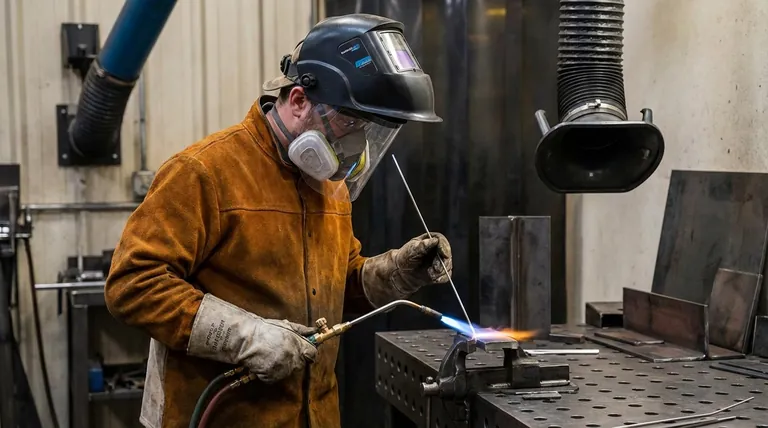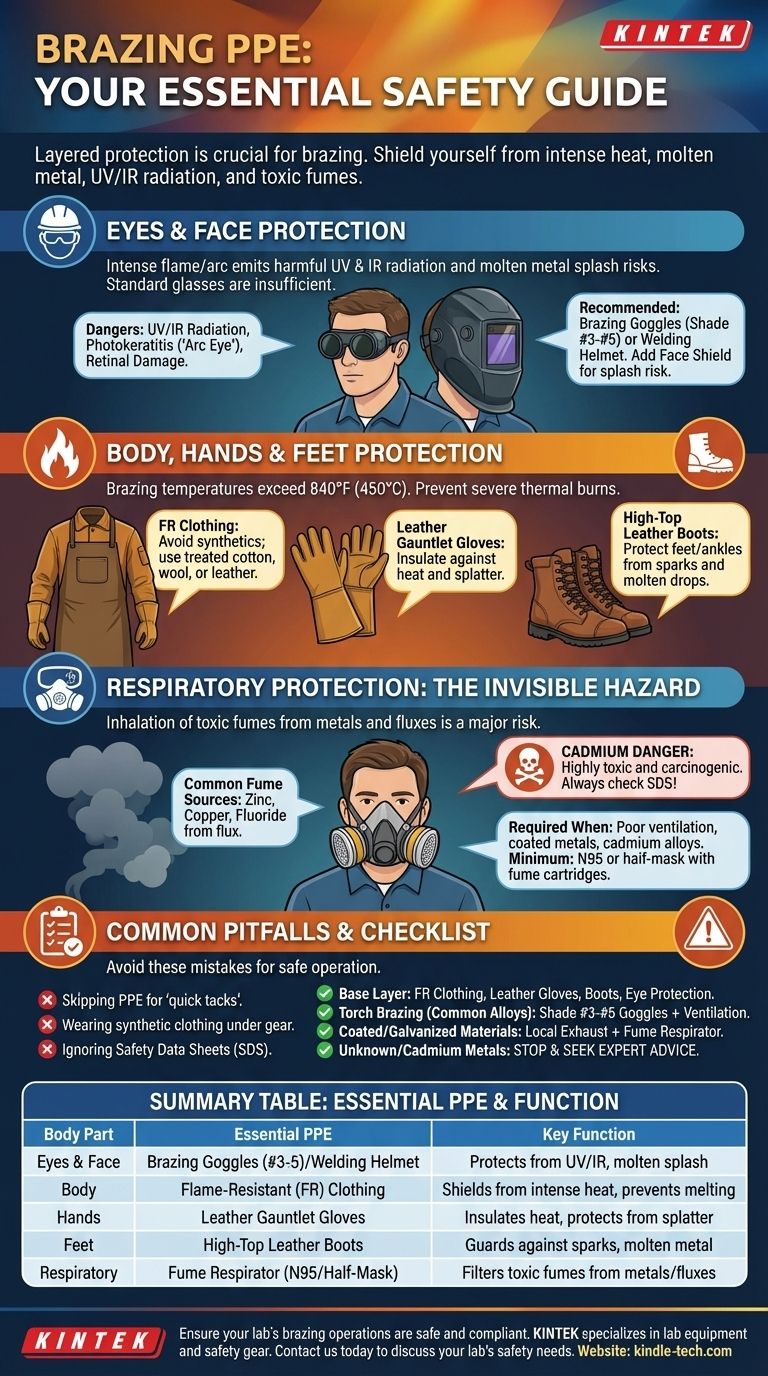At a minimum, proper personal protective equipment (PPE) for brazing includes flame-resistant clothing, leather gloves, high-top leather boots, and specialized brazing goggles or a welding helmet with an appropriate shade. Depending on the materials, flux, and ventilation, a respirator is often a critical addition to protect against hazardous fumes.
The core principle of brazing safety is layered protection. Your PPE must shield you not only from the obvious and immediate danger of intense heat but also from the invisible hazards of ultraviolet radiation and toxic fumes, which can cause long-term harm.

Protecting Your Eyes and Face
The intense flame or arc used in brazing emits harmful radiation and presents a risk of molten metal splash, making eye and face protection non-negotiable.
The Dangers of UV and Infrared Radiation
A brazing torch produces high-intensity ultraviolet (UV) and infrared (IR) light. Prolonged exposure can lead to a painful condition known as photokeratitis, or "arc eye," which feels like having sand in your eyes. Cumulative exposure can cause permanent retinal damage.
Choosing the Right Eye Protection
Standard safety glasses are not sufficient. You must use eye protection specifically designed to filter UV and IR radiation.
- Brazing Goggles: These are the most common choice for torch brazing. They should have a shade rating of #3 to #5, depending on the intensity of the operation.
- Welding Helmets: An auto-darkening welding helmet offers excellent protection for the entire face and can be set to the appropriate low shade for brazing.
Adding a Face Shield
For operations with a higher risk of splash from molten filler metal, a face shield should be worn over your primary shaded goggles or glasses.
Shielding Your Body from Burns
Brazing occurs at temperatures exceeding 840°F (450°C), creating an environment where severe thermal burns are a constant risk from the flame, heated parts, and molten filler metal.
Flame-Resistant (FR) Clothing
Everyday clothing, especially synthetics like polyester or nylon, is a serious hazard. These materials can melt and fuse to your skin when exposed to heat or sparks.
Always wear tightly woven, flame-resistant clothing. Heavy-duty treated cotton, wool, or a leather welding jacket are standard and effective options.
Leather Gauntlet Gloves
Your hands are closest to the heat source. Dry, insulated leather welding gloves (gauntlets) are essential to protect your hands and wrists from the heat and potential splatter of molten metal.
High-Top Leather Boots
Sparks and drops of molten metal can easily fall to the floor. High-top leather boots protect your feet and ankles from burns. Steel-toed boots are a best practice for overall shop safety against impact and compression injuries.
The Invisible Hazard: Fumes and Ventilation
The most overlooked but potentially most dangerous hazard of brazing is the inhalation of toxic fumes. These are generated when the base metals, filler metals, and fluxes are heated.
Understanding Brazing Fumes
The specific fumes depend entirely on the materials you are using. Common hazards include compounds of zinc, copper, and fluoride from flux.
The most severe risk comes from filler metals containing cadmium. Cadmium fumes are highly toxic, can cause severe lung damage, and are carcinogenic. While banned in many applications, old stock may still exist. Always check your material's Safety Data Sheet (SDS).
When is Respiratory Protection Necessary?
Your first line of defense should always be engineering controls, such as local exhaust ventilation (fume extractors) or working in a well-ventilated space.
If adequate ventilation cannot be guaranteed, or if you are working with hazardous materials (like coated metals or cadmium-bearing alloys), a respirator is required. This should be, at minimum, an N95 or a half-mask respirator with cartridges rated for metal fumes.
Common Pitfalls to Avoid
Trust in your process comes from avoiding common mistakes. Being aware of these pitfalls is as important as owning the right gear.
"It's Just a Quick Tack"
Many injuries occur during brief tasks where the operator decides to skip the proper PPE. A severe burn or eye injury can happen in a fraction of a second, regardless of the job's duration.
Assuming All Clothing is Safe
Wearing a synthetic hoodie or polyester shirt under a welding jacket creates a hidden danger. A stray spark can ignite the flammable material underneath your primary protective layer.
Ignoring the Safety Data Sheet (SDS)
The SDS for your filler metal and flux is not just a formality. It is a critical document that explicitly states the chemical hazards, fume components, and the exact PPE required to handle the material safely.
Making the Right Choice for Your Task
Use this checklist to ensure your level of protection matches the risk of your specific brazing operation.
- If your primary focus is any brazing task: You will always need a base layer of FR clothing, leather gloves, leather boots, and properly shaded eye protection.
- If your primary focus is torch brazing common alloys (copper, brass): Ensure your brazing goggles are at least a #3 shade and work in a well-ventilated area.
- If your primary focus is working with coated or galvanized materials: You must use local exhaust ventilation and a fume-rated respirator to prevent metal fume fever.
- If your primary focus is working with older, unknown, or cadmium-bearing filler metals: Stop and seek expert safety advice, as this requires stringent, supplied-air respiratory protection and specialized ventilation.
Ultimately, selecting the correct PPE is a direct reflection of your understanding of the materials and the process, forming the foundation of a safe and professional work habit.
Summary Table:
| Body Part | Essential PPE | Key Function |
|---|---|---|
| Eyes & Face | Brazing Goggles (#3-5 Shade) or Welding Helmet | Protects from UV/IR radiation and molten metal splash |
| Body | Flame-Resistant (FR) Clothing (e.g., leather jacket) | Shields from intense heat and prevents fabric melting |
| Hands | Leather Gauntlet Gloves | Insulates against heat and protects from splatter |
| Feet | High-Top Leather Boots (steel-toed recommended) | Guards against falling sparks and molten metal |
| Respiratory | Fume Respirator (N95 or half-mask) with proper cartridges | Filters toxic fumes from metals and fluxes |
Ensure your lab's brazing operations are safe and compliant with the right equipment. KINTEK specializes in providing high-quality lab equipment and consumables, including safety gear tailored for laboratory environments. Our experts can help you select the appropriate PPE to protect your team from brazing hazards like heat, radiation, and toxic fumes. Contact us today via our contact form to discuss your lab's safety needs and discover how KINTEK can support your commitment to a secure and efficient workspace.
Visual Guide

Related Products
- Custom Machined and Molded PTFE Teflon Parts Manufacturer with PTFE Crucible and Lid
- VHP Sterilization Equipment Hydrogen Peroxide H2O2 Space Sterilizer
- Inclined Rotary Plasma Enhanced Chemical Vapor Deposition PECVD Equipment Tube Furnace Machine
- Alumina Al2O3 Ceramic Crucible Semicircle Boat with Lid for Engineering Advanced Fine Ceramics
- Electron Beam Evaporation Coating Gold Plating Tungsten Molybdenum Crucible for Evaporation
People Also Ask
- What is the best type of crucible? The Answer Depends on Your Application's Needs
- What are crucibles used for in lab? Ensuring Accurate, High-Temperature Sample Analysis
- Why is a PTFE crucible preferred for plasma etching? Ensure Chemical Integrity and Targeted Action
- What are 2 uses of crucible? Mastering High-Temperature Melting and Analysis
- What is the most durable crucible? Match the Right Crucible to Your Melting Application












